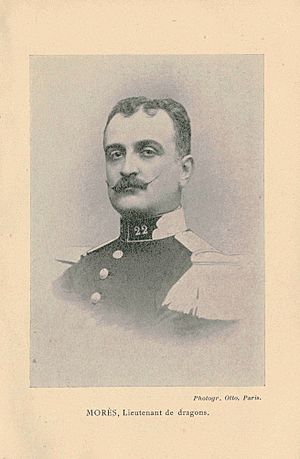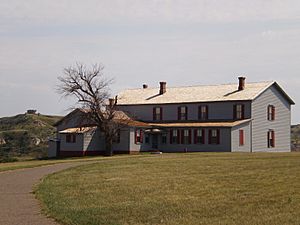Marquis de Morès facts for kids
Antoine-Amédée-Marie-Vincent Manca Amat de Vallombrosa, Marquis de Morès et de Montemaggiore (born June 14, 1858 – died June 9, 1896), known as the Marquis de Morès, was a French adventurer. He was known for being a skilled duelist, a rancher in the American Old West, a pioneer in building railroads in Vietnam, and a politician in France.
Contents
Early Life and Military Training
Antoine-Amédée-Marie-Vincent Manca Amat de Vallombrosa was born on June 14, 1858. As the oldest son of the Duke of Vallombrosa, he used the special title Marquis de Morès. Most people just called him Marquis de Morès.
He started his career as a soldier. In 1879, he graduated from St. Cyr, which was France's top military academy. One of his classmates there was Philippe Pétain, who later became a famous French general.
After St. Cyr, he went to Saumur, France's best school for cavalry officers. He trained there to become an officer. Later, he was sent to Algiers to help stop an uprising. It was in Algiers that he had his first duel. This started his reputation as a well-known duelist of his time.
Adventures in the American Badlands
In 1882, the Marquis left the cavalry. He married Medora von Hoffman, whose father was a wealthy banker from New York. Soon after, he moved to the Badlands of North Dakota. He bought about 44,500 acres (180 square kilometers) of land to start a ranch. He also started a stagecoach business. He built a simple house in Medora, North Dakota, and called it the "Chateau de Mores". This house is now a historic site.
He had a big idea to change the ranching business. He wanted to ship refrigerated meat by train directly to Chicago. This would avoid the need to sell cattle through the large stockyards in Chicago. For this plan, he built a meat-packing plant in Medora. He founded the town in 1883 and named it after his wife, Medora.
However, his plan faced problems. The railroads did not give him the same low shipping prices they gave his competitors. This made his costs higher. Also, people preferred beef that had been fattened on corn in Chicago, not beef that had eaten grass on the open range. The Marquis's father-in-law stopped giving him money for the business. Soon, the packing plant closed. In 1886, as winter arrived, the Marquis and his wife left Medora for good. His time as a rancher in the Badlands ended.
At that time, many outlaws were in the Badlands. Stealing cattle and horses was very common. A frontiersman named Granville Stuart formed a group to fight these rustlers. The Marquis de Morès offered to help this group. However, Stuart decided that the Marquis and Theodore Roosevelt were too well-known. Their presence might ruin the element of surprise. Stuart's group then took strong action against the rustlers. This greatly reduced their power in the Badlands.
By 1885, it was clear that the Marquis's business was failing. He was losing a business battle against the big beef companies. His entire ranching project collapsed. Later, he sold his ranch and other properties in the Badlands.
Railroad Plans in Vietnam
After his time in Dakota, the Marquis returned to France. The French army asked him to build a railroad in Vietnam. This railroad would go from the Chinese border to the Gulf of Tonkin. He arrived in Asia in the fall of 1888 to start the construction. He observed the Vietnamese people and advised the French to treat them kindly. He wrote that "colonization of Tonkin will not be accomplished with rifles, but with public works."
He believed a railroad was important there. He hoped it would even reach Yunnan Province in China. This was partly because the British were building a railroad from Burma to China.
However, politics in France caused problems for the railroad project. A prime minister was removed from power. This led to a new official who was against the Marquis's plan from the start. The Marquis was called back to France in 1889. The railroad project was stopped.
Return to France and Final Journey
When he returned to France, he became involved in political arguments for the rest of his life.
He first tried to challenge the official who stopped his railroad project, but he was not successful. He then joined political groups that held strong views against certain communities. He challenged a Jewish member of the French parliament, Ferdinand-Camille Dreyfus, to a duel. This happened after Dreyfus wrote an article criticizing him. The Marquis said he wanted France for the French. Dreyfus replied that the Marquis had a Spanish title, an Italian father, and an American wife who was not French. In the duel, Dreyfus fired first and missed. The Marquis then wounded Dreyfus in the arm.
In 1889, the Marquis de Morès joined the Antisemitic League of France. After more public statements against Jewish people, he went to Algeria. He wanted to help France strengthen its control there. He also wanted to stop British advances into Africa. He used his strong political views in Algeria. He gave speeches claiming that French and African Jewish people and the British were working together to take over the Sahara Desert.
The British faced difficulties in Sudan after a general died there. The Marquis de Morès planned a trip to meet the Mahdi. The Mahdi was a powerful Muslim leader who wanted to reduce British power in the region. The Marquis traveled to North Africa. He chose Arabic men in Tunis to guide him. His group set out towards Kebili.
A French officer in Kebili received a secret message. It told him not to help the Marquis's trip. It also said to make sure the Marquis traveled through a specific oasis. Another message was sent to a group of Tuareg people. It told them to go to that oasis and kill a Frenchman. The message said the man would have a lot of money and no official guards. It also promised that no one would be punished for killing him.
While in Kebili, the Marquis received a message from a French general. It said that Tuareg guides would be waiting for him at the oasis. The Marquis was surprised because he had not asked for guides. The Marquis left Kebili on May 20. The Tuareg "guides" joined his group on June 3. On the morning of June 9, the Tuareg attacked. The Marquis de Morès managed to kill several of his attackers before he was shot and killed.
On July 28, 1902, a trial was held in Tunisia. Two of the murderers were sentenced. One was sentenced to death, and the other to 20 years of hard labor. During the trial, the Marquis's widow tried to show that the French government was responsible for his death. However, the court did not agree. She even paid someone else to investigate his death, but no government official was ever found guilty.
See also
 In Spanish: Marqués de Morés para niños
In Spanish: Marqués de Morés para niños
- De Mores Packing Plant Ruins, a historic site in the U.S.
- Chateau de Mores, built in 1883 in Medora, North Dakota, also a historic site.
- Von Hoffman House, another historic site in Medora, North Dakota.



